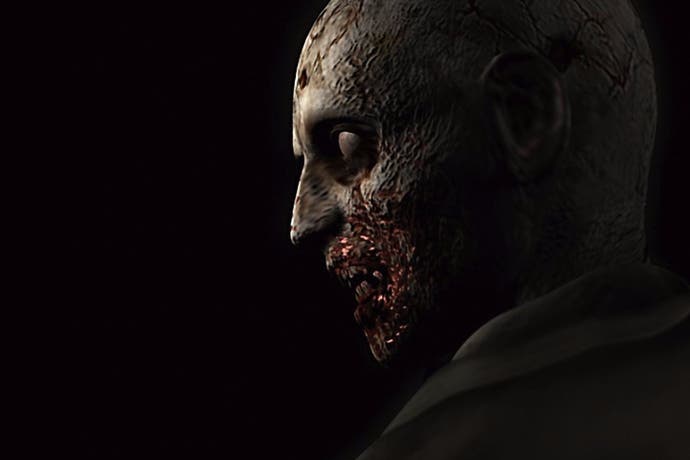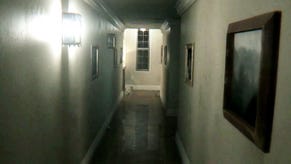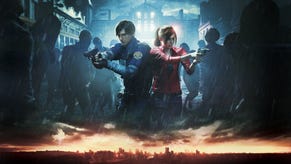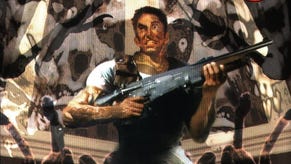Resident Evil - 20 years on
“Victims... were apparently eaten.”
Editor's note: This week saw the 20th anniversary of Capcom's Resident Evil - or Biohazard, if you prefer - and to mark the occasion Rich Stanton looks back at the original. This article was originally published earlier this week.
On the 20th anniversary of a game like Resident Evil there are going to be a hundred articles about Jill sandwiches, bad acting, and all those other encrusted details that accumulate over time. Gaming is a technology-led medium and so, as time passes, such easy trivialities come to define masterpieces that deserve better.
Biohazard, which would be re-named Resident Evil for the western market, began as a remake of an earlier Capcom game. The 1989 NES title Sweet Home, based on a Japanese movie of the same name, was a mesh of horror and RPG where a group of five documentary-makers are trapped in a labyrinthine mansion filled with monsters. Among Sweet Home's more interesting features are that each of the characters can die permanently, each has a particular skill required at points in the game, and there are five different endings depending on who survives.
Director Shinji Mikami would draw inspiration from these elements when drawing out the concept for what would become Resident Evil, but the 1992 game Alone in the Dark was a more direct technical influence. Infogrames' title not only pioneered the use of 3D polygons, digitised pre-rendered backdrops and fixed camera angles - but it also happened to be set in a huge haunted house.
All of this is to say that two things were at the core of Resident Evil: the mansion setting, and the decision to go with fixed camera angles in order to show that environment in as much detail as possible. This is the kind of compromise that developers had to make in the early 3D era, but Mikami's talent as a director shows in how he designed systems around these limitations - and the credit is appropriate because, for the first six months, this was a solo project.
Each aspect of how Resident Evil works moment-to-moment ties into others, and together they're aiming to create fear in the player. The fixed camera angles often give a wide, almost-isometric view of the environments but nearly always contain blind spots - often something as simple as a corner you can't see around. In the more cramped rooms and hallways the camera might be zoomed-in on the character's face, meaning you can see nothing without moving forward, and indeed throughout players are often forced to walk towards the screen. What holds this together is the sound effects.

Sound is the most-underrated element of Resident Evil, and the single most important part of the Arklay Mansion's atmosphere. Enemies make noise: zombies quietly groan as their bodies shuffle and sway; a dog's paws pad back-and-forth; hunters screech like monkeys as they patrol on sticky-sounding feet. Resident Evil has over a minute of zombie groans recorded in different voices, each only lasting a few seconds, because their background presence is such a crucial part of making the camera angles work.
The whole idea is that, when you can see a monster, it has instantly lost a little of what made you scared in the first place. When you can hear a monster, know it's definitely somewhere in the same environment, and have to navigate without clear sightlines - that anticipation is what creates fear. Which introduces an even wider theme in Resident Evil: making players uncomfortable.
This runs through everything from controls to weapons to ammunition to puzzle layouts, and even permeates into the save system. The tank-style controls were a necessity given the regular switches in perspective (pressing 'up' always makes the character run forwards) but also made it difficult to dodge and weave around enemies. The need to ready a weapon before firing fixes the character in position, and each shot has a recovery animation. Ammunition is always at a premium, making every missed shot a longer-term problem and forcing players to use the less-powerful beretta pistol wherever possible.
It's worth pausing on the beretta because it's the most-used weapon in the game, and the functionality and limitations are designed to emphasise the threats you're facing. The gun can be fired relatively quickly, and holds 15 bullets per clip, but each zombie takes between 3-7 bullets to kill - and the bullets barely slow down their shambling advance. Another surprise for new players is that zombies often collapse before they're dead, and will either get up or try to chomp your feet. Experienced players might, when this happens, get in a few hits with the combat knife to save some precious bullets.
As you fight different monsters, the beretta's characteristics change. With fast-moving zombie dogs, which bob and weave around your line of fire, a single bullet will temporarily down the creature, allowing you to finish them off at leisure after one good shot. Against hunters, on the other hand, using the beretta is almost like a deathwish, because it just doesn't have the stopping power to slow them down. Every Resident Evil player knows that feeling of being in a corner, with only the beretta, and knowing that it just won't be enough to stop the incoming attack. But because the ammo is relatively plentiful compared to other weapons, it becomes an essential tactic - almost a point of pride - to eke out beretta damage where you can, running circles around giant tarantulas or plugging away at the snake boss from a distance.

The fact the player doesn't know exactly how many shots each zombie requires is an amazing touch, like the varied groans, because it stops you from ever being certain. There's another minor thread here of limiting information. Resident Evil doesn't give an exact health value for your character, for example, but places it within ranges - green means fine, yellow and orange-yellow mean caution, and red means danger. It's hard to know exactly how close you are to death's door.
It's the accumulation of these details, rather than the ropey FMV, that makes Resident Evil the kind of game that launched a series and is celebrated two decades later. All of these systems are designed to make the player characters and weapons feel 'real' in the distinctly unreal context of zombies and other bio-monsters, and in succeeding they give the Arklay Mansion - the real soul of the game - an uncomfortable, unpredictable atmosphere that permeates far beyond gunplay.
A famous and relatively early scene features an L-shaped corridor with outside windows - as you run down the hall, a dog bursts through a window behind, and as you keep running another bursts through in front. This is a great standalone encounter and also puts a fear of windows somewhere in the player's brain. The trick is never repeated in the same way but the uncertainty it creates - and there are several one-off jump scares like this - persists throughout the remainder.
The Arklay Mansion's interior is elaborately-twisted, and Resident Evil's puzzles and structure are designed to make players crisscross it in different ways as much as possible. Certain doors are locked, requiring a key, while other rooms have elements that will respond to specific items. The puzzles in Resident Evil have been criticised as simplistic, which is fair if you look at them as standalone puzzles, but misses the point that their role is to direct the player's movements.
The real puzzle is in planning your footwork and item capacity while travelling through the mansion. Chris can only carry six items, while Jill can manage eight, but this includes guns, healing items and keys. The puzzles are about pulling the player back-and-forth across the mansion's layout, forcing detours to pick up forgotten items, and encouraging forward planning. Carrying a puzzle item around is a waste of space unless it's going to be used, and so as your familiarity with the mansion and the puzzle rooms grows so too does the effort put into preparation at the item boxes - those glorious, hermetically-sealed havens with no enemies where a peaceful tune plays.
I can visualise the Arklay Mansion now, vividly, and while mentally walking through recall every single room in it. Even now I remember, more-or-less, what keys open what doors - and certainly where all the key items are. It's a big place, and this recollection is not because I have a particularly good memory. It's because Resident Evil squeezes everything it can out of this centrepiece, making players pass through the central atrium countless times, run down the same corridors in different directions, and re-visit rooms long after first finding them. It even, after moving you out of the mansion for a time, brings you back in with a new key and introduces the hunters - combining the temptation to uncover the house's last few secrets with deadlier enemies in new, unfamiliar locations.

This density is exploited to the utmost by another borrowing from Alone in the Dark - two playable characters. But Resident Evil makes much more of this in giving Chris and Jill distinct campaigns, with re-mixed environmental layouts and slightly different abilities. In an inspired touch, it also gives each character a different supporting cast - Chris runs into the rookie Rebecca fairly early, after losing track of Jill and Wesker, while Jill's story focuses on Barry Burton and Wesker. The upshot is that each character's playthrough feels like its own adventure, seemingly-minor differences like item capacity have a big impact, and the remix of an environment you're so familiar with becomes a game unto itself.
Arklay Mansion eventually opens onto an elaborate garden and guest house, before the final act uncovers a nefarious lab, but only the latter has anything like the density of the central location. It is part of Resident Evil's genius, however, that it switches rhythm with the different environments. The garden's airiness is emphasised with high and wide camera angles, moves into cramped sewers filled with hunters and traps, before eventually revealing a juicy secret. The guesthouse serves up the game's most complex puzzle, working out the right formula to kill Plant 42 without fighting it, and adds giant tarantulas and a shark as one-off encounters.
Resident Evil doesn't have a lot of bosses, which speaks to the importance placed on the standard enemy types, and the value of just getting your set-piece encounters right. The giant snake, named Yawn, is terrifying because it's so well-designed around the player's limitations - it curls around the character as you slowly rotate the aim, bullets don't faze it, and at low health it executes a merciless instakill attack that swallows your character whole. In a game that's all about keeping enemies away from your character's body, Yawn is impossible to keep away.
Death is a different experience depending on the game, but Resident Evil is the first time I remember feeling freaked out by the character's demise. The characters are 3D polygon models, and low in detail compared to the lavish environments, but their proportions are humanoid and the animators really had some imagination.
It's for this reason I'll never forget the first time I saw a hunter. They appear after your first return to the mansion, introduced by a first-person FMV cutscene that shows something following the route you've just taken. The cutscene ends, the door opens, and you get a glimpse of this powerfully-built green gorilla, serrated flashes of white suggesting unimaginably sharp claws and teeth. When control is returned to the player, the camera angle shows a long view of the corridor - but the small annex where the hunter's just entered cannot be seen. You know it's there, of course. At low health I raised my gun blindly and fired. There was a raking scream and the hunter flew out of the blind spot, its claw decapitating Chris in one sweep. As his headless body slumped, my jaw hit the floor too.
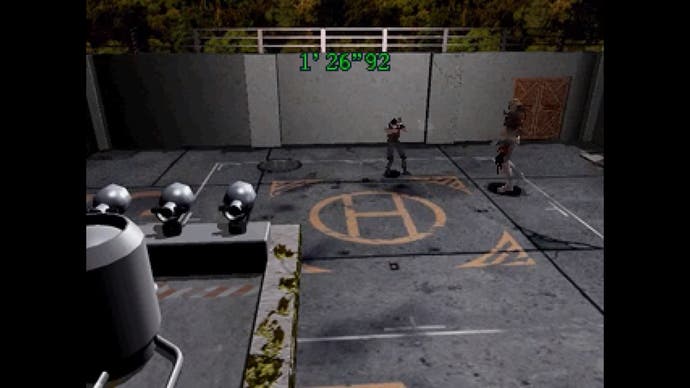
Some might call that bad design - the fact you can't see the hunter, immediately after such an intro. But this is a directorial choice, and to me it translates that terror of confronting something unknown and unexpected into a split-second mechanic of firing into the dark. What happened in my experience wouldn't happen to every player, but the fact it could only made the scare more special. Nothing I'd encountered prepared me for that, and just as I was getting comfortable the game took steps to make sure I wasn't.
There is a technical side to Resident Evil's success that, looking back after two decades of progress, is hard to appreciate. The pre-rendered backdrops remain beautiful and distinctive, even as the industry has moved far past the constraints that brought them to life. But Resident Evil remains a special game because of how well it crafts an environment from them, a labyrinthine rat-run built to be explored, re-explored, and replayed. It understands that horror isn't just about monsters, but about the very presence and threat of monsters. More than anything it understands that players are participants. Resident Evil can do jump scares with the best of them, but far more often it holds back. Why puncture the atmosphere, after all, when players do such a good job of frightening themselves?
Finally Resident Evil marks the emergence of Shinji Mikami as a top-tier director, and it is only right to pay tribute to the kind of special talent that, over six months, designed a game we're still talking about 20 years later. Mikami's mature games share a quality first seen here for subtly eliding the avatar and the player. It's the unexpectedly human details in his heroes, from Leon's aim shivering when he's cold to Sebastian Castellanos getting out of breath when running, which serve to emphasise their vulnerability in these worlds of horror.
For Chris and Jill I always remember how they struggle when the zombies grab hold, the character's desperation taking over as your own agency is temporarily suspended. The way their limbs thrash in panic when grabbed by larger enemies, and how they simply crumple to the floor when killed. One especially horrible touch is how, after a zombie kills you, it can be seen dropping to its knees to continue eating the player's corpse. Often I would close my eyes. Other games have since claimed the phrase but, 20 years on, it's impossible to forget the first time You Died really meant something.
